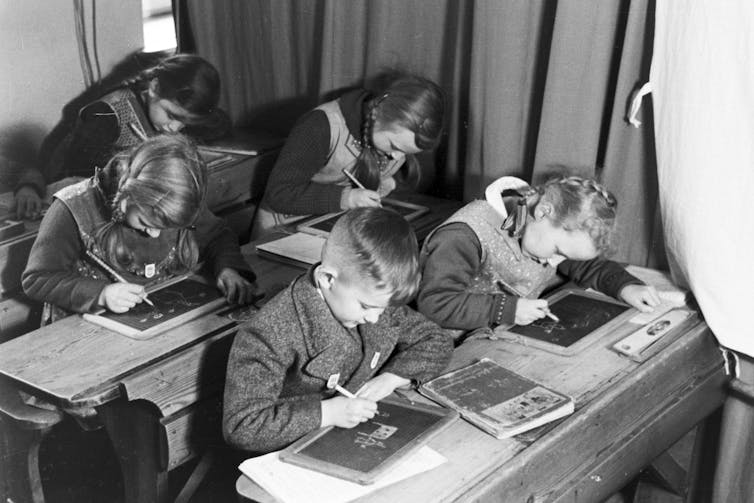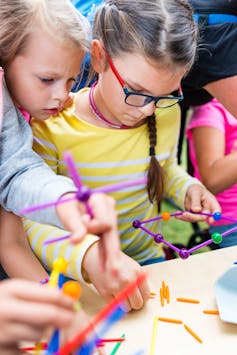
Shutterstock
Anthony Bonato, Ryerson University
There’s a change coming to Ontario’s elementary school math curriculum. The new provincial government says it is responding to a decline of standardized test scores and plans to recommend a return to “back-to-basics” teaching methods for mathematics teachers.
Premier Doug Ford and Minister of Education Lisa Thompson have told educators that directives for changes will be coming within a matter of weeks. Teachers, whose lesson plans for the fall are already drawn, are possibly now scrambling to implement new curriculum guidelines.
Education Quality and Accountability Office (EQAO) scores for students in Grade 6 and Grade 3 in Ontario are both down one percentage point from last year. Previous efforts, including a $60-million initiative by the former Liberal government to improve the EQAO scores, have not worked.
What are ‘back-to-basics’ methods?
What exactly are “back-to-basics” teaching methods for mathematics? These traditional methods of mathematics education include an emphasis on drills, formulas and memorization. If you are old enough, then this was how you were taught mathematics in grade school. In contrast, discovery-based methods spend less time on rules and puts more emphasis on problem solving and applications.
The two methods have somewhat opposing approaches. In traditional methods, rules are taught first and then drilled into students via memorization and solving problems. In discovery methods, problems and examples come first and are abstracted to rules and formulas.

Shutterstock
For example, in a traditional math lesson, children are told the rule that the order of multiplication of two numbers doesn’t matter, and then they would work on problems related to that topic. In discovery math, children would work out examples such as 2 times 3 and 3 times 2, and then abstract this to the general case. Both approaches teach the same thing, but in different ways.
No one should be surprised by these changes after the Progressive Conservatives won a majority in the Ontario election in June. During the election campaign, Ford tweeted, “…We are going to scrap discovery math, and replace it with proven methods of teaching:”
A similar change was announced regarding Ontario’s sex-ed curriculum and elementary school teachers are now required to teach a curriculum essentially dating back to 1998.
Which option is better?
There are pros and cons to both traditional and discovery methods.
My issue with the debate about the “correct” way to teach mathematics to children is the way it is phrased as a binary, either-or approach. The choices we are given are:
1) Drill students on topics such as fractions and timetables.
2) Have children discover math rules and formulas from scratch.
Neither approach in isolation does justice to math education or reflects how people learn mathematics.
Learning rules and formulas in mathematics is an essential skill, as you need a foundation from which to build. Children need to know what the product of 6 and 8 is without having to rediscover it every time.

Shutterstock
At the same time, children gain critical problem-solving skills via discovery. They get to think more deeply about the subject. No one would teach language skills by only teaching grammar. You teach children the rudiments of grammar to get them speaking, reading and writing.
In my university teaching, I employ a mixture of traditional and discovery approaches. For example, in a first-year Calculus course, I introduce a formula or rule at the beginning of a lecture but spend most of the class working out examples interactively with the class so they may figure out how things work. In a more advanced, upper-year mathematics course, I state a theorem or problem, but then break up the class into smaller groups and have the students discover the proof with hints from me along the way.
A third path: Math specialists
When I was in elementary school, our classes had the occasional visit from specialist teachers who focused solely on art or music. These teachers didn’t perform the regular, daily instruction in classes but instead floated between classes enriching the curriculum. It was always a treat when these specialist teachers came and it also was a break from the routine of everyday instruction.
Let’s imagine something like this with mathematics education. Math specialists could be teachers with a mathematics background in their university education, or even math professors or university students with the proper training to engage with elementary school classes. I can think of plenty of fun and engaging lessons in my research area of networks for a Grade 6 class, for example. Math specialists would float between classes with the sole goal of enriching math education for kids.

THE CANADIAN PRESS/Chris Young
Math specialists may assist with the teaching of core material, but more importantly, they would help coach teachers and provide lesson plans that complement the material. Their goals would be to engage students and cultivate their interest in learning mathematics.
While mathematics educators like myself might point to the positive impact of math specialists, research on their effectiveness is still emerging. A study funded by a National Science Foundation at Virginia Commonwealth University found that math specialists have a significant, positive impact on student achievement. Similar results were reported by the National Council of Teachers of Mathematics.
Beyond test scores
While test scores are important, there is much more to mathematics education. Despite the declining EQAO scores, our kids aren’t exactly flunking out of math in droves. The EQAO standards require a 70 per cent or better to qualify as meeting the standard, not the typical passing grade of 50 per cent.
Our children must be exposed to a rich, engaging mathematics curriculum, even if they don’t become mathematicians or have anything to do with STEM (science, technology, engineering, math) directly in their adult lives. Numeracy, like literacy, is an essential skill in our modern world.
A generation with weak math skills will not be competitive to tackle the next set of challenges in our knowledge-based economy. And a dislike of math tends to pass on from one generation to the next. No child should think it makes them cool to boast that they hate math.
While we are rethinking math education in Ontario, let’s use the best of both traditional and discovery methods and add in math specialists. Done correctly, this should not only increase test scores, but also bolster student engagement.
Let’s also take the time and effort to make math fun. Imagine if children were excited to learn mathematics? Isn’t that what we all want?![]()
Anthony Bonato, Professor of Mathematics, Ryerson University
This article is republished from The Conversation under a Creative Commons license. Read the original article.








